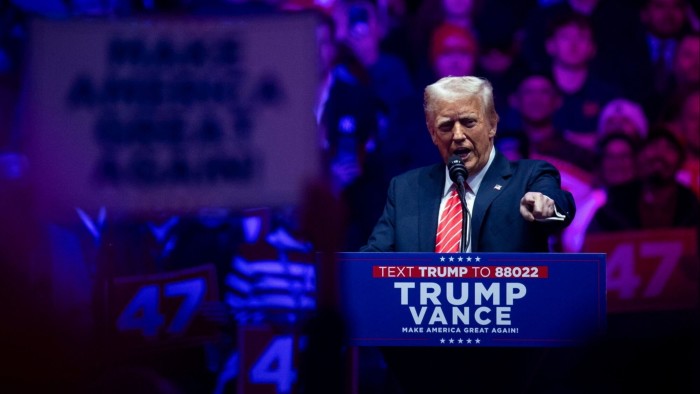The Disinflationary Ripple: Understanding Trump’s Victory and Its Economic Implications
As the political landscape shifts with Trump’s victory, the implications for the U.S. economy are being scrutinized by economists and analysts alike. One of the most intriguing aspects of this shift is its potential long-term disinflationary effects. Disinflation, the slowing of the rate of inflation, may alter the economic fabric of the nation in ways not immediately apparent. This article delves into the intricate relationship between political outcomes, economic trends, and inflation dynamics, providing insights into how Trump’s policies could steer the economy into a new course.
The Political-Economic Nexus
The intersection of politics and economics is a long-studied area, with numerous theories exploring how political shifts can lead to changes in economic conditions. Trump’s victory, particularly in a polarized environment, could lead to various policy changes that might influence inflation rates. The relationship between political governance and economic policy is complex, but certain patterns can be observed.
- Policy Shifts: A change in administration often brings about significant shifts in fiscal and monetary policies. Trump’s approach may focus on deregulation, tax reforms, and trade policies that could affect inflation.
- Market Reactions: Investor sentiment can dramatically change following elections. Anticipated policies can lead to fluctuations in stock markets and commodities, which in turn influence inflation rates.
- Consumer Confidence: Political stability and expected economic policies can impact consumer behavior, affecting spending and saving patterns, which are crucial for inflation dynamics.
Disinflationary Trends: What to Expect
Disinflation can arise from various factors, and Trump’s victory might catalyze some of these trends. Here are a few potential pathways through which disinflation could manifest:
- Supply Chain Adjustments: The U.S. economy has been grappling with supply chain disruptions. If Trump’s administration prioritizes domestic production and resilience over globalization, this could stabilize prices and lead to disinflation.
- Technological Advancements: Trump’s focus on innovation and technology could foster a more productive economy. Increased productivity generally leads to lower costs of goods and services, contributing to disinflation.
- Labor Market Dynamics: Changes in immigration policy and labor availability could affect wage growth. If wage growth slows down due to tighter labor markets, inflation pressures could ease, leading to disinflation.
Inflation Expectations and Consumer Behavior
One of the critical components of inflation dynamics is consumer expectations. If consumers believe that prices will stabilize or decrease, their spending habits will reflect this outlook. Trump’s economic policies could significantly influence these expectations:
- Tax Reforms: If taxes are lowered, consumers may feel more financially secure, potentially leading to increased spending in the short term. However, if these tax cuts are perceived as temporary, longer-term inflation expectations may remain subdued.
- Interest Rate Policies: The Federal Reserve’s response to Trump’s policies will also play a crucial role. If the Fed maintains low interest rates in response to economic uncertainty, it could further anchor inflation expectations.
- Market Stability: A stable political environment often leads to more robust investment and consumer spending. If Trump’s administration successfully creates a perception of stability, it could bolster consumer confidence and mitigate inflationary pressures.
The Global Context: An International Perspective
It’s also essential to consider the global economic landscape when analyzing the potential disinflationary ripple effect from Trump’s victory. The interconnectedness of global markets means that U.S. policies can have far-reaching implications:
- Trade Relations: Trump’s approach to trade could redefine relationships with key partners. Tariffs and trade barriers may lead to short-term inflation, but if negotiations lead to more favorable conditions, disinflation could follow.
- Investment Flows: Political stability can attract foreign investment. An influx of capital could strengthen the dollar, leading to lower import prices and contributing to disinflation.
- Global Supply Chains: A shift in U.S. policy could prompt other countries to reevaluate their economic strategies, potentially leading to a global trend toward disinflation.
Long-term Economic Health: The Role of Innovation and Productivity
Disinflation isn’t inherently negative; it can be a sign of a healthy, growing economy. If Trump’s policies effectively enhance productivity and innovation, the U.S. could enter a period of sustainable growth characterized by stable prices:
- Investment in Technology: Encouraging technological advancements can lead to greater efficiency in production, which typically lowers costs and prices.
- Education and Workforce Development: Investing in human capital ensures that workers are equipped with the necessary skills to thrive in a rapidly changing economy, fostering productivity and growth.
- Infrastructure Development: Improved infrastructure can reduce transportation and production costs, contributing to a more efficient economy and potentially leading to disinflation.
Conclusion: Navigating Uncertainty with Optimism
The potential disinflationary ripple from Trump’s victory raises intriguing questions about the future of the U.S. economy. As policies evolve and the political environment shifts, the interplay between governance and economic trends will be crucial to monitor. While uncertainties remain, understanding how these dynamics interact allows us to navigate the complexities of economic forecasting with a sense of optimism.
Ultimately, the path ahead will depend not only on political decisions but also on the resilience and adaptability of the economy itself. As we look to the future, staying informed and engaged with these developments will empower us to make informed decisions that contribute to economic stability and growth.
See more CCTV News Daily



